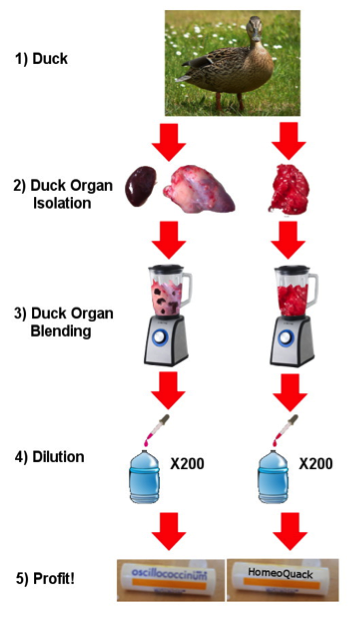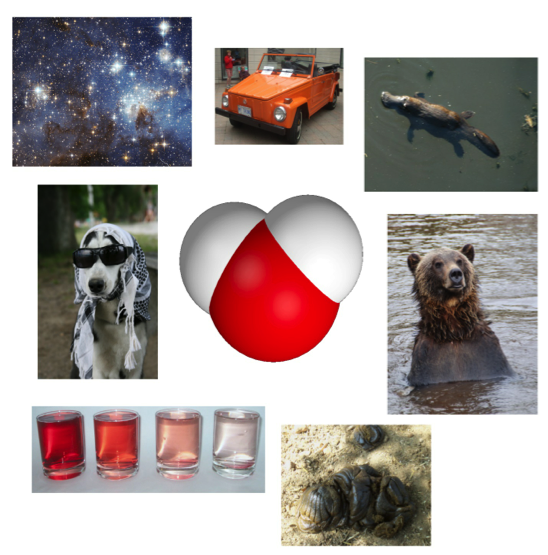
Tweet
October 30, 2014
Proceedings of the Natural Institute of Science | Volume 1 | SOFD 7
Successful clinical trials of HomeoQuack©, a homeopathic vaccine for autism
Faith Eailing1, Bill Kue1, Sue Dohsyents1
1 - Arkedelphia Medical Exploration, Arkadelphia, ARsubmitted: September 26, 2014
accepted: October 2, 2014

Introduction
Up to 90% of all Autism Spectrum Disorders ASDs can be attributed to genetic causes (Freitag 2007), and rarely to any external environmental agent (Gardener et al. 2009; Roman 2007). Despite this wide scientific consensus, we believe ASD almost certainly results from a variety of general environmental causes (Dr. J. A. McCarthy, MD, personal communication).
The difficulty that the scientific establishment, relying exclusively on standard statistical methods, has in finding support for claims of causation for disorders such as ASD is a recurring problem. Use of holistic statistics---in particular the Weight of Evidence Established by Credulity (WEEC)---is much more likely to persuade the general public that otherwise apparently innocuous environmental stimuli result in disease. WEEC arguments have already proven their worth in their support of established environmental causes of autism including: early exposure to the MMR vaccine (Wakefield et al. 1998), having gay parents, gluten-rich diets, having one gay parent and one heterosexual parent, prenatal attacks by invisible owls (Figure 1), having seven gay parents, and fetal masturbation (Meizner 1987). Faced with such a diversity of causes, traditional medicine is incapable of providing a catch-all preventative. Homeopathic medicine, however, offers an impressively wide repertoire of tonics, all named with reassuring scientistic Latinisms. It also has a laudable and possibly scientific emphasis on fitting the remedy to the life history, personality, and the FAITH (Fashion, Anecdote, Ignorance, Tradition, and Hope)-based evidentiary reasoning style of the individual. As such, WEEC logic concludes that homeopathy may offer the greatest benefits to the patient.

In homeopathy, dilutions are key to the efficacy of the remedy: the stronger the dilution, the more powerful the cure (Robert 1853). An exemplar is Oscillococcinum 200C (Boiron USA, Newtown Square, PA) one of the most popular and financially lucrative (Lewis 2012) homeopathic remedies, sold in the United States as a flu prophylactic. This remedy is made once annually from the heart and liver of a single duck, which are liquefied and diluted to a ratio of one part duck organs, 10200 parts water (Salzberg 2010). This dilution schedule ensures that no atoms from the original duck remain in the remedy itself. As further proof (as if more were needed) of the power of dilution, we note that Oscillococcinum is ethically suitable for vegans, Jains, and fruitarians as a direct consequence of having had no direct contact with any animal product. Here, we outline a treatment plan for a homeopathic vaccination of autism that follows the lead of the Oscillococcinum remedy, and report results of our first clinical trial.
Methods
Vaccine Development- Autism manifests itself in the brain, so we secured the brain of the 2013 Oscillococcinum duck (“Steve”) to use in manufacture of our remedy. Because this particular duck was not known to be autistic our choice of material may a priori seem to violate the “like cures like” tenet of homeopathy (Gross and Weiner 1989). Likewise, duck livers might also seem to have no obvious relationship with the influenza virus. However, here we propound a deeper tenet of homeopathy, based on WEEC argument and philology. The Latin phrase foie gras, i.e. duck liver, is actually a cognate of foie grave, or deadly flu. Similarly cerebrus gras, or duck brain, can be taken as a cognate of cerebrus grave, or serious mental [illness] i.e. autism. FAITH based criteria such as the Philological Principle have been increasingly recognized and subjected to scientific scrutiny (note in particular Cha and Wirth 2001).
We blended the duck brain in an Osterizer Single Speed Beehive Blender (Sunbeam Products, Boca Raton, FL) and then performed the same steps used in the manufacture of Oscillococcinum (Figure 2): 1 part liquified duck tissue diluted in to 99 parts water, with dilutions repeated serially 200 times. After 200 dilutions, the resulting ratio of duck brain tissue to water made it statistically unlikely that the remedy contained even one atom from the original duck (Neinhuys 2003), which will save money on ducks when this vaccine moves into broad production (and make it suitable for use by Hari Krishnas, Seventh Day Adventists, and other vegetarian members of the FAITH based community). As in all other homeopathic remedies, the absence of any remnant of the original material is an expected result of dilutions: it is the “essence” of the duck brain, rather than any physical remnant of the diluted substance, that provides the curative (Ullman 2002, see also Mason 2010 for a discussion of the possible influence of Quantum Indeterminacy in this process); in plain words, the duck brain is “remembered” by the water molecules that encounter it – incidentally demonstrating the efficacy of the Cartesian Dictum cogito ergo natavitque, or, “I think therefore I swam” (Descartes 1644). We will refer to our final curative as Molecular Memory of Mallard Brain, Osterized Palliative (MMMBOP).
We verified the purity of MMMBOP using standard, double blind methodology and a single undergraduate volunteer (UV). Examining 50 ml of solution of MMMBOP vs 50 ml of distilled water (as a control), in identical beakers, the UV could not distinguish the two solutions based on 3 criteria: 1) did MMMBOP look like a duck (LD: df=1, chisq=0.21, p=0.64), 2) walk like a duck (WD: df=1, chisq=0, p=1), or 3) quack like a duck (QD: df=1, chisq=0.88, p=0.35) more than the control, based on 10 repeated trials for each criterion. We also found no statistical evidence that the identity of the UV biased the results (i.e., it wasn’t one of us), validating our protocol and reinforcing the notion that MMMBOP was, in fact, sufficiently pure.
MMMBOP was incorporated into sugar pills for drug delivery (Figure 2).

Clinical Trials - A trial set of 5000 female volunteers, ranging in age from 20 to 35, were selected for our clinical study. Half of this population was designated as the control group and given sugar pills. The other half was designated as the experimental group and given MMMBOP. Both groups were then monitored for a period of 15 years. All births that occurred during this time were recorded, and regular developmental checkups of resulting children were performed up to age 5.
Statistical Analyses - All conventional statistics were conducted within Excel (Microsoft Office 95), a highly powered analytic tool used for extracting correct answers from data. All tests performed were chi square tests, which enable you to tell if an effect is real or something. Data were entered into a square “matrix” in Excel, and the function “=CHITEST(B2:C2, B3:C3)” was applied, and p-values extracted using “=CHIDIST(D3,1)”. P-values less than 0.05 were deemed to be “significant”. Holistic statistical implementation of WEEC Demonstration of Implied Causality (WEEC-DIC) was performed using standard FAITH-based inference.
Results and Discussion
A total of 1342 children were born to the control group. Of these, 15 (1.1%) were identified as having a disorder somewhere on the autism spectrum. Among the experimental group, 1288 children were born. Of these, 19 (1.5%) were on the spectrum. While our results appear to show no statistical difference between control and experimental groups (df=1, chisq=0.45, p=0.50), a more careful analysis reveals a strong and positive effect of the homeopathic vaccine. Confounding our results was the problem that each individual hydrogen and oxygen atom found in the water used in dilutions was almost certainly contaminated with the essence of every other substance it had contacted, however briefly, since its origin in an ancient star (Figure 3). While many or most of these essences likely improve general health of the patient, others are among the exhaustive list of substances that homeopathically cause autism (including, e.g., the HPV vaccine, “santorum”, genetically engineered Bt corn, and Snooki). As these influences were found to be responsible for at least 17 of the 19 incidences of ASD in the experimental groups using a WEEC Demonstration of Implied Causality (WEEC DIC = 9.999, est=16.83, p=10E-16) we can safely remove them from our results. Statistical comparison of corrected results shows conclusively that the vaccine was broadly successful (df=1, chisq=7.76, p=0.005).

Though autism is not an infectious disease, and despite the fact that no homeopathic remedy of any sort has been shown to increase antibody counts in patients more than a placebo would, we nevertheless call our remedy a “vaccine”. Again, using the Philological Principle, the word “vaccine” derives from the Latin vaccus, or cow, which may be taken as a cognate of vacuum or absence. Since ingestion of MMMBOP during pregnancy is likely to completely eliminate autism (apart from the difficult case of fetii practicing self-abuse, or due to unavoidable contamination from autism-inducing agents on the memory of the water itself) this absence of illness qualifies MMMBOP as a vaccine. Moreover, since we are dealing with Absence of Evidence, not Evidence of Absence (Moreland and Craig 2003), by established WEEC arguments the onus of proof is on those who would claim that we are wrong.
In conclusion, we note that drug companies willing to expound upon the efficacy of remedies using FAITH based advertising strategies, and resorting to WEEC reasoning will be able to our leverage the cost-effective manufacturing techniques of MMMBOP to procure commercial supplies of HomeoQuack from the authors for as cheaply as $600 for a year’s supply (suggested retail price, $1500). As with all other homeopathic remedies (FDA Warning Letter 2010), HomeoQuack is not FDA approved.
Acknowledgments
We would like to thank M Oz, D Chopra, and M Bachmann for their comments on an earlier version of the manuscript, and for their contributions to the mathematical analyses performed.
References
Cha KY, Wirth DP (2001). Does prayer influence the success of in vitro fertilization–embryo transfer? report of a masked, randomized trial. J Reprod Med 46 (9): 781–787. [since retracted, presumably as a result of a concerted attack by the scientific establishment, who have a highly questionable bias against FAITH based criteria and WEEC arguments.]
Descartes, R. Principles of Philosophy, Gutenberg Printing Press.
FDA Warning Letter to Homeopathy For Health. 2010.
Freitag CM. The genetics of autistic disorders and its clinical relevance: a review of the literature. Mol Psychiatry. 2007;12(1):2–22.
Gardener H, Spiegelman D, Buka SL. Prenatal risk factors for autism: comprehensive meta-analysis. Br J Psychiatry. 2009;195(1):7–14.
Gross, K. and Weiner M. 1989. The Complete Book of Homeopathy. Fine Communications. New York, NY.
Lewis, A. 2012. Boiron settles for $12M to stop homeopathy lawsuits. The Quackometer (blog)
Mason, Phil (2010). Quantum Glory: The Science of Heaven Invading Earth. Maricopa, AZ: XP Publishing. p. 150. ISBN 9781936101597.
Meizner, J, 1987 Sonographic observation of in utero fetal “masturbation”. J Ultrasound Med. Feb 6(2): 111
Moreland, J.P.; Craig, W.L. (2003). Philosophical Foundations for a Christian Worldview. InterVarsity Press. pp. 155–156.
Nienhuys, J.W. 2003. The true story of Oscillococcinum. HomeoWatch (blog)
Robert ED (1853), Lectures on the theory & practice of homeopathy (PDF), London: B. Jain, pp. 526–7, ISBN 81-7021-311-8.
Román GC. Autism: transient in utero hypothyroxinemia related to maternal flavonoid ingestion during pregnancy and to other environmental antithyroid agents. J Neurol Sci. 2007;262(1–2):15–26.
Salzberg, S. 2010. Homeopathic Flu “Cures” and Dead Ducks. Forbes Magazine online:
Ullman, D. MPH. Essential Homeopathy: What It Is and What It Can Do for You. New World Library, Novato. California, January 2002.
Wakefield, et al. 1998. Ileal-lymphoid-nodular hyperplasia, non-specific colitis, and pervasive developmental disorder in children. Lancet 351: 637-641 [also retracted; see note for Cha et al.]

Proceedings of the Natural Institute of Science (PNIS) by https://instsci.org/ is licensed under a Creative Commons Attribution-ShareAlike 4.0 International License.